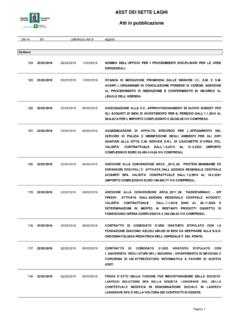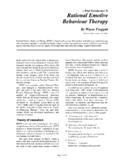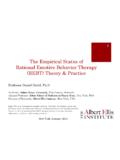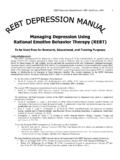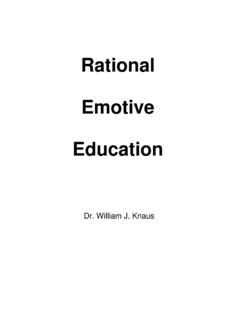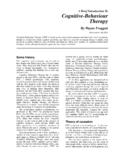Transcription of Chapter 4 Albert Ellis and the Model of REBT: The ABC ...
1 Chapter 4 Albert Ellis and the Model of REBT: The ABC Model of Psychotherapy What upsets people are not things in themselves but their judgments aboutthings. For example, death is nothing dreadful (or else it would haveappeared so to Socrates), but instead the judgment about death is dreadful that is what is dreadful. Epictetus, p. 326 From the Psychodynamic to the Philosophical Perspective: The Development of the ModelRational Emotive Behavioral Therapy (REBT) is a cognitive-behavioral modeldeveloped by Albert Ellis during the mid-20th century. Ellis , a clinical psychol-ogist, trained in psychoanalysis, part of the training process for a psychothera-pist at that time. Ellis completed his training in 1947 and started hissupervisionary training, employing traditional psychoanalytic methods withhis clients. To his dismay, he realized their inefficiency as a mode of questioned the number of sessions, the length of therapy, the passivity ofthe therapists, and the role of transference in resolving the clients past parentalconflicts.
2 The insights that he observed were important but insufficient ininducing a change in the client s disturbance. Like Beck, Ellis noted clients self-talk as a source of their disturbance. He termed what Beck referred to as automatic thoughts as self-statements and irrational beliefs, while agreeingwith Beck s observation of the tendency of depressed and anxious individuals tothink automatically about themselves as failures. Ellis went on to say: I knew from my first year of using REBT with scores of clients that behindtheir automatic unrealistic thoughts were often unconscious, deeper eval-uations that really led to their disturbances and even helped them 3/17/07 3:46 PM Page 80their disturbed thoughts. For example, if I fail at this valuable relationship,and if people despise me for failing that will mean I am a rotten failure andan incompetent person. And if I fail at this task, I ll be no good at any-thing important, and because being successful is beneficial, I ll be an ineptindividual.
3 ( Ellis , 1994a, p. xvi) Ellis decided to terminate his psychoanalytic training and later publishedhis seminal paper, Rational Psychotherapy, presented in 1956 at the Ameri-can Psychological Association s Annual Convention in Chicago. The firstedition of his book Reason and Emotion in Psychotherapyappeared in 1962; in ithe outlined his ideas about human nature and psychotherapy. In the 1950sEllis was interested in Pavlovian ideas about dogs that responded to signaling(presenting food with or without noxious stimuli), which resulted inapproaching or avoiding the meat presented to them. He soon realized, how-ever, that unlike dogs, human approach or avoidance processes involved eval-uations of self-consciousness or thinking about thinking (1994a, p. 11). Ellis observed that humans can define, create, and evaluate real life(pleasant or stressful) situations as well as imagined ones. This was tobecome a central tenet in his REBT Model of explaining human disturbanceor distress.
4 The introduction of the distinction between preferences, wishes,and desires (rational thinking) as functional forms of thinking, and absolutistneeds and must (irrational thinking) as stress-increasing ones, laid thefoundation of Ellis s ABC Model of psychotherapy. These two alternativeforms of thinking represent two contradictory yet innate human is the innate human tendency to interpret in an absolutist manner theoccurrence of adverse situations ( It shouldn t have happened and if it did,it s awful ), while the other is the strong biological human motivation tochange or improve things for the better (including changing one s defeatistthoughts and feelings).In the ABC Model Ellis included also the G (Goal) component that rep-resents the human motivation to change and achieve one s goals. The D(Disputation) and the E (new Effect) represent the importance of disputingirrational thoughts that block the individual s motivation.
5 Both tendenciesare apparent in this Model . Next to the wishes and desires to achieve goals,humans have a tendency to construct musts and demands that block themfrom actualizing themselves. When disputation (D) has successfully beenapplied, the result is a new Effect (E). The emphasis is on the choice onehas to construct preference-focused beliefs (rational beliefs) or demand-focused beliefs (irrational beliefs). While the former increase the likelihood ofmore satisfying life activities, the latter are more likely to increase Ellis and the Model for REBT: The ABC Model of 3/17/07 3:46 PM Page 81 Ellis postulated that the innate tendency to think irrationally is universal,and is assumed to have had survival reasons which nowadays are no longerfunctional. Human personality disturbances are thus a combination of bio-logical predisposition and cultural-environmental factors. Adopting theseviews can explain Ellis s departure from the psychoanalytic approach of view-ing human disturbance as related to unresolved conflicts with parental figuresin early childhood (which in psychoanalytic therapy can be overcome withan insight about it).
6 Rather, he came to view the past as a given event whichcannot be changed, although the meaning that one attributes to it can(according to REBT, attributed meanings about one s past are changeable).Right from its inception the cognitive Model focused on the centrality ofcognitions as a source in understanding emotional disturbance, but empha-sized the circularity between thoughts and feelings. Related to the centralityof cognitions are two kinds of anxieties that Ellis refers to, ego anxiety that isidentified in most CT psychotherapy, and discomfort anxiety, which he iden-tified as a source of emotional disturbance. While ego anxiety is the client stotal self-downing of themselves, discomfort anxiety deals with the client slow frustration tolerance. Discomfort anxiety is emotional hypertension thatarises when people feel (1) that their life or comfort is threatened, (2) thatthey must not feel uncomfortable and have to feel at ease, and (3) that it isawful or catastrophic (rather than merely inconvenient or disadvantageous)when they don t get what they supposedly must get (1994a, p.)
7 253).Another important concept relates to secondary symptoms of concept stemmed from Ellis s observation that people tend to make eval-uations about their thinking. The following quotation from the first editionof Reason and Emotion in Psychotherapy(1962) describes the construction of thethinking about thinking error:If you strongly construct negative feelings (C1) such as panic and severedepression about unfortunate Activating Experiences (A1) you then maycreate a set of rational beliefs (rB2) about your (C1) such as I don t like feel-ing panicked. I wish I were not. But also often create a set of irrationalBeliefs (iB2) about your (C1), such as I must not be panicked! It s awful tofeel this way. I can t stand it! I am no good for making myself panicked! You then have pronounced secondary symptoms (C2) about your primaryones (C1) . (p. 19)Again, it is not the negative event and the construing of negative feelingsabout it that produces distress, but evaluating the negative feelings experi-enced as ones that ought, should, and must not occur, is what is likely toincrease emotional distress and therefore is considered as a disturbance about82 Cognitive Grief 3/17/07 3:46 PM Page 82disturbance ( Ellis , 1962, 1994a).
8 In REBT in particular, secondary (or even terti-ary) symptoms of disturbance are identified, assessed, and followed by showingthe clients how to minimize their stresses that the link between the A (Activating event) the B (Belief),and the C (Consequence) is cyclical; also thinking, emoting, and acting areinteractional; though thinking is a major source for creating distress, it can bechanged into a more functional one. In other words the way we think influ-ences the way we feel and behave as much as the way we feel and behaveaffects our thinking. Secondary symptoms are the evaluation of how wemight feel under certain negative circumstances (thinking about the fear I willexperience if I enter the elevator increases the panic I experience).Core Philosophy and the Belief-Consequence Connection:Functional and Dysfunctional EmotionsWhen first formulating his cognitive Model , Ellis (1962, 1994a) assumed thatemotional problems resulted from people talking to themselves in a self-defeating manner, but realized that self-talk only partially explained it.
9 Peo-ple s core philosophy underlying self-talk was the reason for disturbance. Acore philosophy (schema according to Beck) is the person s construction ofpast experiences with people or events with which they evaluate or interpretsimilar potential events or experiences. These processes are formed in earlychildhood and continue to be repeated in self-talk both consciously andunconsciously ( below-the-surface irrational belief, Ellis , 1994a, p. 28) andare activated under what is perceived by the person as an adverse core philosophy is shaped in early childhood, its repeated construc-tion and reconstruction (indoctrinationis the term used by Ellis (1994a)becomes an integral part of the worldview. In his words (1994a),Once I had clearly begun to see that neurotic behavior is not merelyexternally conditioned or indoctrinated at an early age, but that it is alsointernally reindoctrinated or auto-suggested by people to themselvesuntil it becomes an integral part of their presently held (and continuallyself-reiterated) philosophy of life, my work with my clients took on aradically new slant.)
10 (p. 30)Clearly, a philosophical approach aimed at helping people change themeaning they attribute to their past experiences replaced a psychodynamicorientation where the therapist s aim is to help clients focus on their Ellis and the Model for REBT: The ABC Model of 3/17/07 3:46 PM Page 8384 Cognitive Grief TherapyHow does emotional disturbance develop? It is likely to occur when indi-viduals evaluate, based on core philosophy, their strong wishes to actualizethemselves in a demanding and absolutist manner. There are three main cate-gories: Demanding directed toward the self, toward others, and toward theworld; demanding (absolutist musts, shoulds, and oughts) that takes the formof self-devaluation, devaluing others, and devaluing the world; and low frus-tration tolerance (LFT), and awfulizing. In the REBT Model of therapy, Ellis (1994a) stressed the universality ofthe tendency to think irrationally, the demand-based interpretation thatself, others, and the world should be the way one wants them to be, andthat human construction of demanding is carried out in an the Model was called Rational Therapy to indicate the role ofcognitions in understanding emotional disturbance, and to distinguish it frommore traditional psychodynamic therapies that viewed emotional symptomsas the sole key to understanding disturbance.
